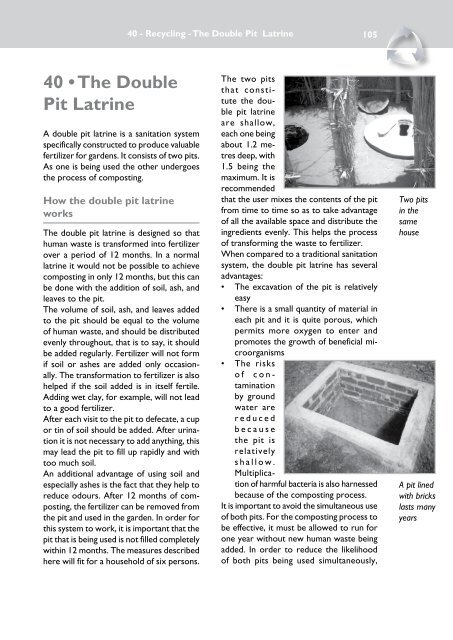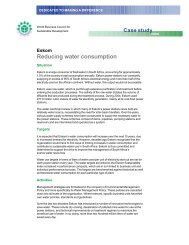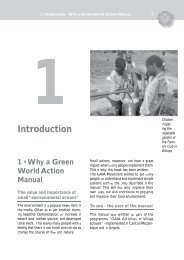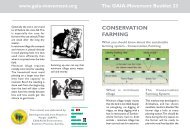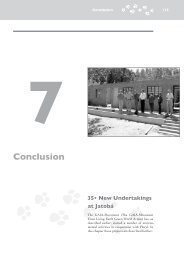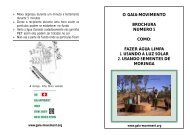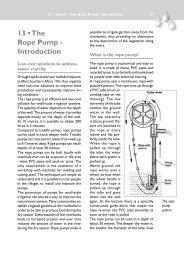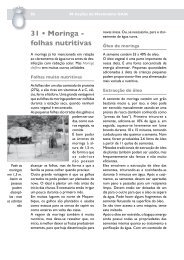40 • The Double Pit Latrine - The Gaia-Movement
40 • The Double Pit Latrine - The Gaia-Movement
40 • The Double Pit Latrine - The Gaia-Movement
You also want an ePaper? Increase the reach of your titles
YUMPU automatically turns print PDFs into web optimized ePapers that Google loves.
<strong>40</strong> <strong>•</strong> <strong>The</strong> <strong>Double</strong><br />
<strong>Pit</strong> <strong>Latrine</strong><br />
A double pit latrine is a sanitation system<br />
specifically constructed to produce valuable<br />
fertilizer for gardens. It consists of two pits.<br />
As one is being used the other undergoes<br />
the process of composting.<br />
How the double pit latrine<br />
works<br />
<strong>The</strong> double pit latrine is designed so that<br />
human waste is transformed into fertilizer<br />
over a period of 12 months. In a normal<br />
latrine it would not be possible to achieve<br />
composting in only 12 months, but this can<br />
be done with the addition of soil, ash, and<br />
leaves to the pit.<br />
<strong>The</strong> volume of soil, ash, and leaves added<br />
to the pit should be equal to the volume<br />
of human waste, and should be distributed<br />
evenly throughout, that is to say, it should<br />
be added regularly. Fertilizer will not form<br />
if soil or ashes are added only occasionally.<br />
<strong>The</strong> transformation to fertilizer is also<br />
helped if the soil added is in itself fertile.<br />
Adding wet clay, for example, will not lead<br />
to a good fertilizer.<br />
After each visit to the pit to defecate, a cup<br />
or tin of soil should be added. After urination<br />
it is not necessary to add anything, this<br />
may lead the pit to fill up rapidly and with<br />
too much soil.<br />
An additional advantage of using soil and<br />
especially ashes is the fact that they help to<br />
reduce odours. After 12 months of composting,<br />
the fertilizer can be removed from<br />
the pit and used in the garden. In order for<br />
this system to work, it is important that the<br />
pit that is being used is not filled completely<br />
within 12 months. <strong>The</strong> measures described<br />
here will fit for a household of six persons.<br />
<strong>40</strong> - Recycling - <strong>The</strong> <strong>Double</strong> <strong>Pit</strong> <strong>Latrine</strong><br />
105<br />
<strong>The</strong> two pits<br />
that constitute<br />
the double<br />
pit latrine<br />
are shallow,<br />
each one being<br />
about 1.2 metres<br />
deep, with<br />
1.5 being the<br />
maximum. It is<br />
recommended<br />
that the user mixes the contents of the pit<br />
from time to time so as to take advantage<br />
of all the available space and distribute the<br />
ingredients evenly. This helps the process<br />
of transforming the waste to fertilizer.<br />
When compared to a traditional sanitation<br />
system, the double pit latrine has several<br />
advantages:<br />
<strong>•</strong> <strong>The</strong> excavation of the pit is relatively<br />
easy<br />
<strong>•</strong> <strong>The</strong>re is a small quantity of material in<br />
each pit and it is quite porous, which<br />
permits more oxygen to enter and<br />
promotes the growth of beneficial microorganisms<br />
<strong>•</strong> <strong>The</strong> risks<br />
o f c o n -<br />
tamination<br />
by ground<br />
water are<br />
r e d u c e d<br />
b e c a u s e<br />
the pit is<br />
relatively<br />
s h a l l o w .<br />
Multiplication<br />
of harmful bacteria is also harnessed<br />
because of the composting process.<br />
It is important to avoid the simultaneous use<br />
of both pits. For the composting process to<br />
be effective, it must be allowed to run for<br />
one year without new human waste being<br />
added. In order to reduce the likelihood<br />
of both pits being used simultaneously,<br />
Two pits<br />
in the<br />
same<br />
house<br />
A pit lined<br />
with bricks<br />
lasts many<br />
years
106<br />
there should only be one latrine slab in the<br />
system.<br />
<strong>The</strong> system can be equipped with a portable<br />
structure, like the Arborloo (see previous<br />
section), so that moving the superstructure<br />
from one pit to the other is easy and convenient.<br />
Alternatively, the double pit latrine<br />
can have a have a permanent structure<br />
covering both pits; many such systems exist<br />
in Mozambique and Malawi.<br />
Excavating, or “digging out” conventional<br />
pit latrines after use is not commonly practised<br />
in Africa, or in any part of the world.<br />
Consequently, first time users of the double<br />
pit latrine are cautious at first about this<br />
part of the latrine management process.<br />
Some users will not immediately agree to<br />
excavating the pit. <strong>The</strong>y will need to be<br />
convinced. It helps if potential users can<br />
see other double pit latrine pits excavated<br />
without difficulty, and examine the humus<br />
<strong>40</strong> Green World Actions<br />
for themselves. It also helps if they can see<br />
evidence that the mixing of the humus with<br />
poor local top soil does actually enhance<br />
the growth of vegetables. After a season<br />
of use, however, they will be persuaded of<br />
the benefits of the system.<br />
If the pit has been filled up faster than expected<br />
and there is doubt about the safety<br />
of the compost, then it can be transferred<br />
to sacks for storage for an additional length<br />
of time. By excavating and placing the compost<br />
in bags, the material is turned and aerated,<br />
and this certainly helps to promote the<br />
composting process. This period of extra<br />
composting in bags may also be preferred if<br />
it is not the season for planting vegetables.<br />
(Alternatively, some gardeners may prefer<br />
to dig the humus into the bed some time<br />
in advance of planting.)
108<br />
41 <strong>•</strong> Wastewater<br />
Reuse<br />
How to reuse wastewater in a<br />
safe way<br />
This section demonstrates some simple<br />
systems for recycling wastewater from<br />
kitchens and baths (grey water) so that it<br />
can be used for watering in the vegetable<br />
and flower garden and - with extra treatment<br />
- also for other purposes such as<br />
bathing or washing.<br />
<strong>The</strong>re is less and less fresh water available<br />
for people around the world. This is because<br />
populations are increasing on the one<br />
hand, while more water is getting polluted<br />
by salt or chemicals on the other. Besides<br />
collecting more rainwater, one response to<br />
this problem is to reuse as much wastewater.<br />
In many places, wastewater from baths<br />
and kitchens goes directly into the ground.<br />
This water could instead be used to water<br />
vegetables or flowers. <strong>The</strong> nutrients in<br />
wastewater will also fertilize the garden.<br />
In developed countries, wastewater is<br />
treated to:<br />
<strong>•</strong> avoid the spread of diseases caused by<br />
microorganisms<br />
<strong>•</strong> reduce the amount of nutrients containing<br />
nitrogen and phosphate, which cause<br />
water pollution<br />
Most microorganisms that spread diseases<br />
do not grow outside the body, but can<br />
survive if they are inside faeces. This is why<br />
wastewater from toilets (black wastewater)<br />
should never be used untreated for irrigation<br />
or fertilisation. Grey water does not<br />
normally contain these microorganisms<br />
and can be used safely in simple ways as<br />
described below. Many developed countries<br />
have strict rules as to what is allowed.<br />
<strong>40</strong> Green World Actions<br />
Wastewater has to be filtered through a<br />
sand or soil filter (this can be done decoratively<br />
as a flower bed). After this it is often<br />
only allowed to be used for underground<br />
irrigation or for flushing toilets.<br />
Developing countries have less strict rules<br />
and it is possible to make safe systems<br />
where the grey wastewater is reused for<br />
irrigation. It can also be treated very simply<br />
so that it can be used for general purposes<br />
like bathing, washing, etc. by:<br />
<strong>•</strong> filtering it through a simple sand filter<br />
in a drum or container<br />
<strong>•</strong> sending it through a shallow pond containing<br />
duckweed<br />
<strong>•</strong> sending it through a reedbed system<br />
containing plants like vetiver<br />
<strong>The</strong> purpose of the filter is to remove food<br />
waste, hair etc. This can be done easily by<br />
filtering the water through a drum or a<br />
container filled with sand. This will remove<br />
practically all organic material from the<br />
wastewater. Some nutrients (nitrogen and<br />
phosphate) will still be there, but these are<br />
good for plants. <strong>The</strong>re is no need to remove<br />
them if the water is going to be used in the<br />
garden. <strong>The</strong> sand filter will eventually fill up<br />
with waste, and the top layer should then be<br />
changed. Because the waste in the sand is all<br />
organic it can just be buried in a hole.<br />
A duckweed pond or reedbed can be used<br />
to clean the waste water so that it can be<br />
used for bathing and washing. A duckweed<br />
pond might be appropriate for people who<br />
keep chickens or ducks since duckweed is<br />
very good feed for them. However, with<br />
a duckweed pond there is a daily requirement<br />
to remove some of the duckweed.<br />
A reedbed needs less attention. Once or<br />
twice a year the plants in the reedbed, such<br />
as vetiver grass, need to be cut. This can<br />
then be used for thatching or as mulch in<br />
the garden. If you are using vetiver grass,<br />
new plants - “tillers” - will be formed at the
ase. <strong>The</strong>se can be harvested and sold to<br />
be used to make contour rows to prevent<br />
erosion.<br />
How to make a sand filter<br />
<strong>•</strong> Take a fuel drum or plastic barrel that<br />
has a top with an opening so you can<br />
connect a tube to it. This will be the<br />
outlet opening.<br />
<strong>•</strong> Cut out the bottom, hammering where<br />
you cut to avoid sharp edges<br />
<strong>•</strong> Connect the outlet of the drum to a<br />
hose, either using a fitting to the hole in<br />
the drum or using tyre rubber to make<br />
the attachment leak-proof<br />
<strong>•</strong> Turn the drum upside down and raise<br />
it on some stones so the outlet is free<br />
<strong>•</strong> Tie a piece of mosquito net like a bag<br />
over the drum outlet<br />
<strong>•</strong> Fill the drum with sand<br />
<strong>•</strong> Tie a piece of mosquito net like a bag<br />
around the hose or pipe bringing wastewater<br />
to the filter<br />
<strong>•</strong> This bag should be emptied every day<br />
of the waste collected<br />
<strong>The</strong> sand filter can be connected to the<br />
pond or reedbed with pipes if water can<br />
run down by itself. Or you can simply move<br />
the filtered water with a bucket.<br />
How to make a duckweed pond<br />
<strong>The</strong> size of the pond required depends on<br />
how much water it has to treat. For every<br />
1000 litres of water you use per day you<br />
will need a pond that is 2 square metres in<br />
area and about 50 cm deep. Mosquito larvae<br />
cannot survive if the duckweed layer is<br />
complete, but if you are in an area with high<br />
incidence of malaria, it is probably better to<br />
make a reedbed system.<br />
Before you start, make sure that you can<br />
find duckweed in your area. It usually grows<br />
41 - Recycling - Wastewater Reuse<br />
109<br />
on any small<br />
pond containing<br />
many nutrients,<br />
for example<br />
where<br />
there are cattle<br />
or towns<br />
nearby.<br />
<strong>•</strong> M a k e a<br />
hole 50 cm<br />
deep in the ground<br />
<strong>•</strong> Make the pond narrow - not more than<br />
2 metres wide - to ensure it is easy to<br />
harvest<br />
<strong>•</strong> Cover the base of the reedbed with a<br />
sheet of plastic (not necessary if water<br />
does not penetrate into the soil)<br />
<strong>•</strong> Fill the pond with (waste) water<br />
<strong>•</strong> Make a system so that overflow water<br />
can run out of a pipe instead of flowing<br />
over the sides<br />
<strong>•</strong> Tie a net<br />
over the<br />
i n l e t o f<br />
this pipe,<br />
so that the<br />
duckweed<br />
c a n n o t<br />
flow out<br />
<strong>•</strong> Collect the<br />
treated water in a container<br />
Use the water for gardening until the duckweed<br />
are growing well.<br />
Later it can be used for general purposes,<br />
but should be treated before drinking by<br />
boiling or using the SODIS system (solar<br />
disinfection - see section 4). Harvest the<br />
duckweed every one or two days by removing<br />
half of it with a net. <strong>The</strong> harvested<br />
duckweed is good food for chickens - it can<br />
make up one third of their food. Duckweed<br />
can also be dried in the sun and used later<br />
or sold as feed.<br />
Duckweed<br />
can also<br />
be used as<br />
chicken<br />
feed<br />
A child<br />
collects<br />
duckweed<br />
pushing<br />
the duckweeds<br />
together<br />
using a<br />
stick
110<br />
How to make a simple reedbed<br />
system<br />
<strong>•</strong> Make the bed - by removing soil to a<br />
depth of <strong>40</strong>-50 cm. <strong>The</strong> reedbed should<br />
be created at a relatively low-lying location<br />
where the wastewater can flow<br />
easily downwards to the reedbed.<br />
<strong>•</strong> <strong>The</strong> size of the reedbed should be about<br />
one square metre per person in the<br />
household<br />
<strong>•</strong> Cover the base of the reedbed with a<br />
sheet of plastic (not necessary if water<br />
does not penetrate into the soil)<br />
<strong>•</strong> Put a drainpipe (a PVC pipe with slots<br />
- cut with a saw) at the bottom where<br />
the treated water can run out<br />
<strong>•</strong> Tie a piece of net around the inlet of<br />
the drainpipe<br />
<strong>•</strong> Cover the drain pipe with a layer of<br />
small stones or shells. <strong>The</strong>n fill the<br />
reedbed with sand<br />
<strong>40</strong> Green World Actions<br />
<strong>•</strong> Plant reeds such as vetiver, bamboo,<br />
papyrus, or wetland plants such as canna<br />
lilly or iris<br />
<strong>•</strong> Lay the pipe delivering wastewater<br />
across the reedbed. Close off the end<br />
and make many small holes in the pipe,<br />
so that the wastewater is distributed<br />
right across the reedbed.<br />
<strong>•</strong> Collect the treated water in a container<br />
Use the water for gardening until the plants<br />
are growing well. Later it can be used for<br />
general purposes but should be treated before<br />
drinking - by boiling or using the SODIS<br />
system (solar disinfection - see section 4).<br />
<strong>The</strong> cultivated reed bed - or constructed wetland. <strong>The</strong> plants use the nutrients and<br />
microorganisms in the sludge decompose the organic material. <strong>The</strong> waste water is thus<br />
cleaned. In most tropical areas the evaporation is high, and it is then not necessary to have<br />
a drain for excess water


